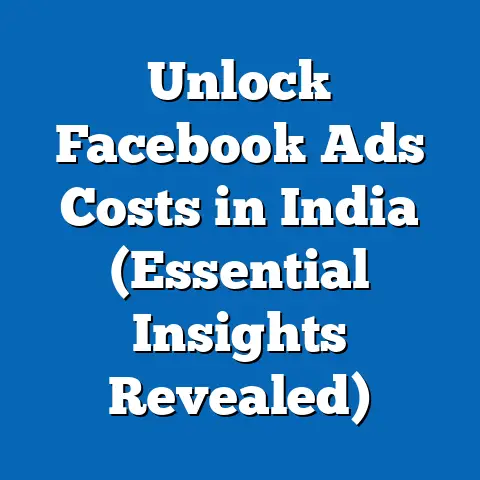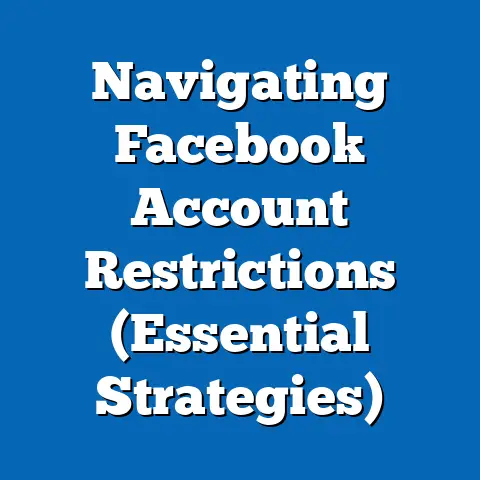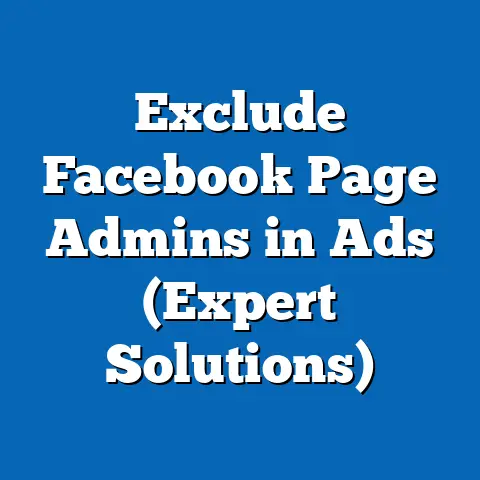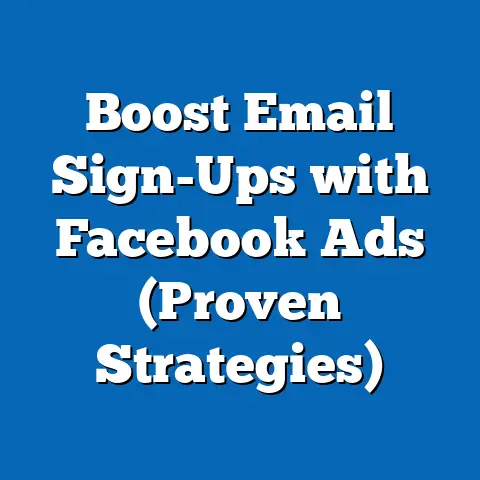Overcoming Facebook Ad Set Limits (Expert Troubleshooting Tips)
Platforms like Facebook (now part of Meta) have become indispensable tools for businesses, advertisers, and content creators seeking to reach targeted audiences. However, navigating the complexities of Facebook’s advertising ecosystem often presents challenges, one of the most common being ad set limits—restrictions on the number of ad sets a user can create or manage within a single ad account. This article provides a comprehensive analysis of ad set limits on Facebook, exploring their defining characteristics, historical context, and societal implications, before delving into expert troubleshooting tips to overcome these constraints.
With over 2.9 billion monthly active users as of 2023, Facebook remains a dominant force in social media advertising, offering unparalleled reach and precision targeting. Yet, the platform’s policies, including ad set limits, can create significant hurdles for advertisers managing large-scale campaigns or multiple clients. By understanding the roots of these limits and their broader impact, advertisers can better navigate the platform and optimize their strategies.
Understanding Facebook Ad Set Limits: Key Defining Characteristics
At its core, a Facebook ad set is a component of an advertising campaign that defines the audience, budget, schedule, and placement of ads. Ad set limits refer to the maximum number of ad sets an account can create or run simultaneously, a policy implemented by Facebook to maintain system performance and prevent abuse. As of the latest updates in 2023, the default limit for most ad accounts is 5,000 ad sets per account, though this can vary based on account history, spending levels, and other factors.
These limits are not arbitrary; they are tied to the technical infrastructure of Facebook’s ad platform, which processes billions of data points daily to deliver personalized ads. When an account exceeds its ad set limit, it may face restrictions on creating new campaigns or experience delays in ad delivery. This can be particularly problematic for agencies or businesses running high-volume campaigns across multiple products or regions.
It’s important to note that ad set limits are distinct from other restrictions, such as daily spending caps or account-level bans. While spending limits are tied to financial thresholds, ad set limits are a structural constraint designed to ensure the platform’s stability. Understanding these nuances is critical for advertisers aiming to scale their efforts without running afoul of platform policies.
Historical Context: Evolution of Facebook Advertising Policies
Facebook’s advertising platform, launched in 2007 with the introduction of “Facebook Flyers,” has undergone significant changes over the past decade and a half. Initially, the platform offered rudimentary targeting options with minimal restrictions, allowing advertisers to experiment freely. However, as the user base grew and the ad ecosystem became more sophisticated, Facebook introduced stricter policies to balance user experience with advertiser needs.
The concept of ad set limits emerged around 2014-2015, coinciding with the rollout of the modern Ads Manager interface. At the time, Facebook was grappling with system overloads caused by advertisers creating thousands of low-budget, poorly optimized ad sets—a tactic often used to “game” the algorithm. To address this, the platform began imposing caps on ad sets, alongside other measures like the 20% text rule for ad images (later relaxed) and restrictions on certain content categories.
By 2019, as reported by industry sources like AdEspresso, the default ad set limit was formalized at around 5,000 per account, though high-spending accounts could request increases through Meta’s support channels. The COVID-19 pandemic in 2020 further underscored the need for such limits, as a surge in online advertising strained server capacities. Historical events like these highlight how external factors, from technological constraints to global crises, have shaped Facebook’s policies over time.
These evolving rules reflect a broader tension in digital advertising: the balance between scalability for advertisers and platform integrity for users. As Facebook’s algorithms became more data-intensive, ad set limits became a necessary tool to prevent spam and ensure equitable access to the platform’s resources.
Societal Implications of Ad Set Limits
The implementation of ad set limits on Facebook has far-reaching implications for businesses, marketers, and society at large. At the economic level, these limits can disproportionately affect small and medium-sized enterprises (SMEs) that rely on granular targeting to compete with larger brands. For instance, an SME running niche campaigns for multiple product lines may quickly hit the 5,000 ad set cap, forcing them to consolidate campaigns and potentially lose precision in targeting.
Conversely, ad set limits can level the playing field by curbing the ability of large corporations or unscrupulous advertisers to flood the platform with low-quality ads. This aligns with broader societal concerns about digital advertising ethics, including data privacy and ad fatigue among users. By enforcing limits, Facebook indirectly addresses user complaints about repetitive or irrelevant ads, which can erode trust in the platform.
Culturally, ad set limits reflect the growing scrutiny of Big Tech’s role in shaping information flows. In an era where social media influences everything from consumer behavior to political discourse, restrictions on ad volume can mitigate the risk of misinformation campaigns—a concern amplified by events like the 2016 U.S. presidential election. However, these limits also raise questions about access and equity, as advertisers with the resources to navigate or appeal limits gain an advantage.
From a workplace perspective, ad set limits have reshaped the digital marketing industry by necessitating new skills in campaign optimization and automation. Marketers must now prioritize efficiency over volume, a shift that has spurred demand for tools like automated rules and third-party ad management software. This evolution underscores how platform policies can drive broader professional and technological trends.
Technological and Economic Factors Influencing Ad Set Limits
Technologically, ad set limits are a direct response to the immense computational demands of Facebook’s ad delivery system. Each ad set requires the platform to process vast amounts of data—demographic details, behavioral signals, and real-time bidding metrics—to determine which ads reach which users. Without limits, the system risks slowdowns or crashes, as evidenced by occasional outages reported by advertisers during peak usage periods like Black Friday.
Economically, ad set limits are tied to Facebook’s revenue model, which prioritizes high-quality, high-spending advertisers. Accounts with larger budgets or a history of compliance are often granted higher limits, creating a tiered system that incentivizes investment in the platform. According to a 2022 report by eMarketer, Meta’s ad revenue reached $114.9 billion in 2021, with a significant portion coming from top-tier advertisers who benefit from relaxed constraints.
This economic dynamic also reflects broader market trends, such as the consolidation of digital ad spend among major players. While ad set limits aim to prevent abuse, they can inadvertently favor established brands over startups, exacerbating inequalities in the digital economy. Understanding these technological and economic underpinnings is essential for crafting strategies to work within—or around—these limits.
Expert Troubleshooting Tips for Overcoming Ad Set Limits
Navigating ad set limits requires a blend of strategic planning, technical know-how, and creative problem-solving. Below are expert-level tips to help advertisers maximize their reach without exceeding platform constraints. These solutions are grounded in best practices shared by industry leaders and insights from Meta’s own documentation.
1. Optimize Existing Ad Sets for Efficiency
Before creating new ad sets, audit your current campaigns to identify underperforming or redundant ones. Use Facebook’s Ads Manager to analyze metrics like cost-per-click (CPC) and return on ad spend (ROAS), then consolidate overlapping ad sets targeting similar audiences. For example, instead of running separate ad sets for each age bracket, combine them into a single set with dynamic creative optimization (DCO) to test multiple ad variations.
Consolidation reduces clutter in your account and frees up space for new campaigns. Additionally, leverage automated rules to pause or adjust ad sets based on performance thresholds, minimizing manual oversight. This approach not only helps stay under the limit but also improves overall campaign efficiency.
2. Utilize Campaign Budget Optimization (CBO)
Facebook’s Campaign Budget Optimization feature allows advertisers to set a single budget at the campaign level, letting the algorithm distribute funds across ad sets dynamically. By using CBO, you can reduce the number of ad sets needed, as the system prioritizes high-performing audiences automatically. This is particularly useful for accounts nearing their limit, as it minimizes the need for granular budget allocation across multiple ad sets.
To implement CBO effectively, start with a small test campaign to gauge how the algorithm allocates budget. Adjust audience sizes and creative elements based on early results, ensuring the system has enough data to optimize. Industry reports suggest that CBO can reduce costs by up to 30% when used correctly, making it a powerful tool for limit-constrained accounts.
3. Request a Limit Increase from Meta
For accounts with a consistent spending history and compliance record, requesting an ad set limit increase is a viable option. Meta allows advertisers to submit appeals through the Ads Manager or by contacting a dedicated account representative, if available. Be prepared to provide details about your account activity, campaign goals, and reasons for needing a higher limit.
While approval is not guaranteed, accounts spending over $10,000 monthly or managing multiple clients (e.g., agencies) are more likely to succeed, according to anecdotal evidence from marketing forums like Reddit’s r/PPC. To strengthen your case, ensure your account adheres to Meta’s advertising policies and maintains a low rate of ad disapprovals. Persistence and clear communication are key when navigating this process.
4. Distribute Campaigns Across Multiple Ad Accounts
If a limit increase isn’t feasible, consider splitting campaigns across multiple ad accounts. This is a common strategy for agencies or businesses managing diverse product lines or geographic regions. Each new account starts with its own ad set limit, effectively multiplying your capacity.
However, managing multiple accounts requires robust organization to avoid confusion or policy violations. Use tools like Business Manager to oversee all accounts from a single dashboard, and assign unique payment methods to each to prevent accidental overlaps. Note that Meta may scrutinize accounts created solely to bypass limits, so ensure each account serves a legitimate, distinct purpose.
5. Leverage Third-Party Tools and Automation
Third-party ad management platforms, such as Hootsuite Ads, Smartly.io, or AdEspresso, can streamline campaign creation and optimization, reducing the need for numerous ad sets. These tools often provide bulk editing features, advanced analytics, and automation capabilities that help advertisers achieve results with fewer resources. For instance, Smartly.io’s predictive algorithms can identify high-potential audiences without the need for extensive manual segmentation.
While these tools come with subscription costs, the time and efficiency gains often outweigh the expense, especially for high-volume advertisers. Be sure to choose a tool that integrates seamlessly with Meta’s API to avoid data discrepancies. Many of these platforms also offer tutorials and support to help users adapt to limit constraints.
6. Focus on Broader Targeting Strategies
Ad set limits often push advertisers to rethink overly granular targeting approaches. Instead of creating separate ad sets for every demographic or interest group, adopt broader targeting combined with lookalike audiences or interest stacking. Lookalike audiences, for example, allow Facebook’s algorithm to find users similar to your best customers, reducing the need for multiple ad sets.
This shift aligns with Meta’s push toward automated targeting, as seen in features like Advantage+ campaigns introduced in 2022. While broader targeting may feel counterintuitive, studies by WordStream indicate it can lower acquisition costs by up to 20% when paired with strong creative. Test and iterate to find the right balance between reach and specificity.
7. Archive or Delete Unused Ad Sets Regularly
A practical yet often overlooked solution is to routinely clean up your ad account by archiving or deleting inactive or completed ad sets. Facebook counts all ad sets—active or not—toward your limit, so removing clutter can free up space for new campaigns. Use the “Filter” option in Ads Manager to identify ad sets with zero impressions or spend over a set period (e.g., the past 90 days).
Before deleting, export performance data for record-keeping or future analysis. Archiving is a safer option if you’re unsure about permanently removing ad sets, as it preserves historical data without counting toward the limit. Regular maintenance prevents unexpected roadblocks and keeps your account organized.
8. Stay Updated on Policy Changes
Facebook’s ad policies, including limits, are subject to change based on platform updates, user feedback, and regulatory pressures. Subscribe to Meta’s Business Blog or join industry communities like the Facebook Ads & Marketing group on LinkedIn to stay informed about shifts in ad set limits or related features. Proactive awareness can help you adapt strategies before limits become a bottleneck.
Additionally, monitor your account’s status through the Account Quality dashboard in Ads Manager, which flags potential issues or upcoming restrictions. Staying compliant with Meta’s evolving guidelines reduces the risk of sudden limit reductions or account suspensions.
Comparing Ad Set Limit Challenges Across Business Types
The impact of ad set limits varies across different types of advertisers, reflecting the diversity of needs within the digital marketing ecosystem. Small businesses, often operating on tight budgets, may struggle with limits when trying to test multiple audience segments, as they lack the resources to manage multiple accounts or invest in premium tools. In contrast, large enterprises with dedicated marketing teams can more easily absorb the costs of third-party solutions or limit increase requests, though they may face internal inefficiencies due to the sheer scale of their campaigns.
Agencies managing multiple clients face unique challenges, as they must juggle ad set limits across diverse portfolios. A 2021 survey by Social Media Today found that 68% of agency marketers cited platform restrictions like ad set limits as a top barrier to scaling client campaigns. Meanwhile, e-commerce businesses, which often rely on dynamic product ads, may hit limits faster due to the need for separate ad sets per product or category.
These differences highlight the importance of tailored strategies. While a small business might focus on consolidation and broader targeting, an agency could prioritize multiple accounts and automation. Recognizing these variations prevents a one-size-fits-all approach and fosters more effective troubleshooting.
Implications for Digital Marketing and Beyond
Ad set limits are more than a technical constraint; they shape the broader landscape of digital marketing and user engagement. For marketers, these limits underscore the need for adaptability and innovation, pushing the industry toward smarter, data-driven strategies over brute-force tactics. The rise of automation and AI-powered tools, for instance, is partly a response to such platform restrictions, signaling a long-term shift in how campaigns are managed.
For society, ad set limits contribute to ongoing debates about the power of tech giants like Meta. While they help curb ad spam and protect user experience, they also centralize control over who can advertise and how often, raising questions about fairness and access. As regulators worldwide scrutinize digital advertising—evidenced by the EU’s Digital Markets Act in 2023—these policies may face further evolution, potentially altering the balance of power between platforms and advertisers.
In the workplace, ad set limits have accelerated the demand for specialized skills in campaign optimization and cross-platform advertising. Marketers who can navigate Meta’s constraints while diversifying into platforms like TikTok or Google Ads are increasingly valuable, reflecting a broader trend toward versatility in the field. This shift also highlights the interconnectedness of technological policies and professional development.
Forward-Looking Insights and Uncertainties
Looking ahead, the future of ad set limits on Facebook remains uncertain, shaped by technological advancements, user behavior, and regulatory pressures. Meta’s ongoing investment in AI and machine learning may reduce the need for strict limits by improving system efficiency, potentially allowing for higher caps or dynamic thresholds based on real-time server capacity. However, growing privacy concerns and legislation like the California Consumer Privacy Act (CCPA) could lead to tighter restrictions on ad volume and targeting, indirectly reinforcing limits.
Advertisers must also anticipate shifts in user demographics and platform usage. As younger generations gravitate toward platforms like Instagram (also under Meta) and TikTok, Meta may adjust ad policies to retain advertisers, possibly by offering incentives for consolidated campaigns or cross-platform integrations. Yet, the unpredictability of user trends and global events—like economic downturns affecting ad spend—adds layers of complexity to forecasting.
Ultimately, overcoming ad set limits requires a proactive mindset: staying informed, experimenting with new tools, and embracing flexibility. While challenges persist, they also present opportunities to refine strategies and build resilience in an ever-changing digital landscape. By understanding the roots and ramifications of these limits, advertisers can turn constraints into catalysts for innovation, ensuring sustained success on one of the world’s most powerful advertising platforms.
This article, while comprehensive, is a starting point for navigating Facebook ad set limits. With practical tips grounded in data and context, it aims to equip advertisers with the knowledge to adapt and thrive. As Meta continues to evolve, so too must the strategies of those who rely on its ecosystem—a dynamic that promises both challenges and opportunities for years to come.






